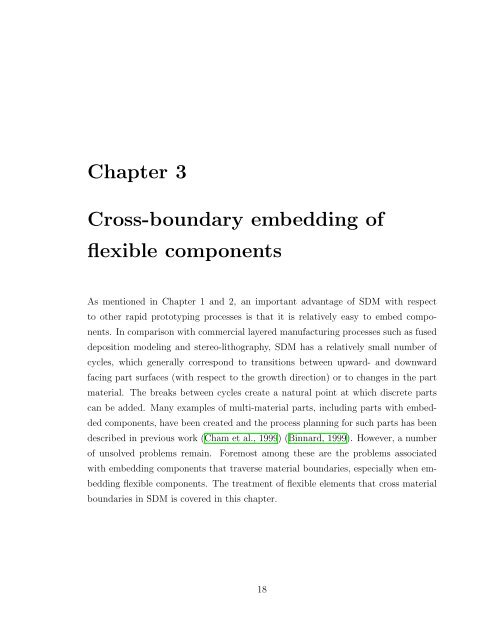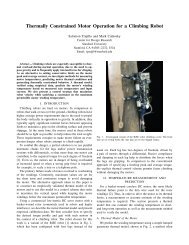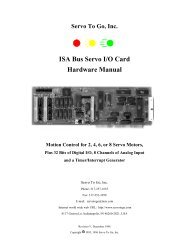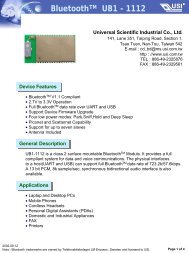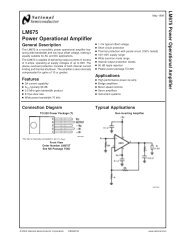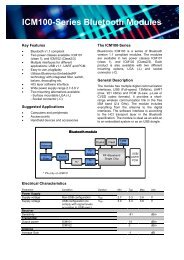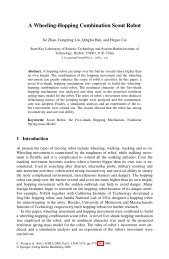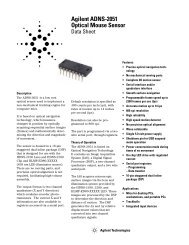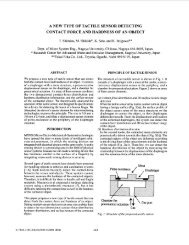- Page 1 and 2: DESIGN AND FABRICATION OF MULTIMATE
- Page 3 and 4: I certify that I have read this dis
- Page 5 and 6: or in bulk. Consideration of fabric
- Page 7 and 8: my parents busy at home while I’v
- Page 9 and 10: 2.2.1 Application, modeling, and th
- Page 11 and 12: List of Tables3.1 Design and materi
- Page 13 and 14: 4.1 Coordinate system definition .
- Page 15 and 16: Chapter 1IntroductionJuu yoku gou w
- Page 17 and 18: 31.1.1 Conventional fabricationOne
- Page 19 and 20: 5referred to as sacrificial materia
- Page 21 and 22: 7Figure 1.2: SDM robot featuring em
- Page 23 and 24: 9stiffness limitations of flexures.
- Page 25 and 26: Chapter 2Previous WorkIn order to p
- Page 27 and 28: 132.1.2 Previous component embeddin
- Page 29 and 30: 15have produced a very similar flex
- Page 31: 17• bonding.The material is large
- Page 35 and 36: 213.2.1 Materials and manufacturing
- Page 37 and 38: 233.3 Partial and cross-boundary em
- Page 39 and 40: 25• Bulk removal: Uncontrolled ma
- Page 41 and 42: 27for the pre-encapsulation process
- Page 43 and 44: 29Suspending fixture methodAnother
- Page 45 and 46: 31Selective material removal takes
- Page 48 and 49: 3412I-3I-4Create mold and fixturePl
- Page 51 and 52: 37Figure 3.9: Finished mechanism wi
- Page 53 and 54: 39that is anchored in solid polymer
- Page 55 and 56: 41Figure 3.12: Photograph of the fi
- Page 57 and 58: 43SU-8 (photocurable polymer)Embedd
- Page 59 and 60: 45V-1V-2V-3V-4Create a tight mold f
- Page 61 and 62: 47and risk elimination of flexible
- Page 63 and 64: 49Pseudo-boundary formation Pre-enc
- Page 65 and 66: 51STARTDesign / RedesignDirect boun
- Page 67 and 68: 53obstructed by it, and avoiding st
- Page 69 and 70: Chapter 4Stiffness modification of
- Page 71 and 72: 57Let us assume the flexure to have
- Page 73 and 74: 59The suggested fiber configuration
- Page 75 and 76: Figure 4.2: Each column illustrates
- Page 77 and 78: Figure 4.4: The cones in the lower
- Page 79 and 80: 65based on the strain condition at
- Page 81 and 82: 67effectively produce 18[Nmm] of to
- Page 83 and 84:
69The stiffness ratio between pitch
- Page 85 and 86:
71rotY5.004.004.20rotY7653.002.001.
- Page 87 and 88:
73rotY5.004.003.00rotY76542.001.001
- Page 89 and 90:
75rotY5.004.003.00rotY76542.001.001
- Page 91 and 92:
77rotY5.004.003.00rotY76542.001.001
- Page 93 and 94:
79rotY5.004.003.004.49rotY76543.932
- Page 95 and 96:
81rot Y5.00rot Y74.0065rot -X3.002.
- Page 97 and 98:
83the significant Y stiffening and
- Page 99 and 100:
85rot Y5.00rot Y74.0065rot -X0.303.
- Page 101 and 102:
87rot Y5.00rot Y7rot -X4.003.002.00
- Page 103 and 104:
89rot Y5.00rot Y74.0065rot -X0.343.
- Page 105 and 106:
91The strings are configuredas in a
- Page 107 and 108:
93a05a19a11a06a01ControlFigure 4.25
- Page 109 and 110:
95Machine mold cavity for rigid end
- Page 111 and 112:
97largely prevented to simplify mea
- Page 113 and 114:
99Control piecePlease see figure 4.
- Page 115 and 116:
101rotY5.00rotY74.003.002.001.004.2
- Page 117 and 118:
103rot Y5.00rot Y74.006rot -X3.002.
- Page 119 and 120:
105rotY5.004.003.004.49AnalysisrotY
- Page 121 and 122:
107rotY5.004.003.004.82AnalysisrotY
- Page 123 and 124:
109for the geometric nonlinearity,
- Page 125 and 126:
111X-bendY-bendZ-torsionControla01M
- Page 127 and 128:
113Figure 4.37: Photograph of faile
- Page 129 and 130:
115evidence of elastomer infiltrati
- Page 131 and 132:
117elastomer, similar to those obse
- Page 133 and 134:
Chapter 5Conclusion5.1 SummarySever
- Page 135 and 136:
121via embedded wiring that runs ac
- Page 137 and 138:
123Ashby, M. (1999). Materials Sele
- Page 139 and 140:
125Cooper, A. (1999). Fabrication o
- Page 141 and 142:
127Li, X., Stampfl, J., and Prinz,
- Page 143 and 144:
129Nutt, K. (1991). Selective laser
- Page 145 and 146:
131Stubbs, N. and Thomas, S. (1984)


